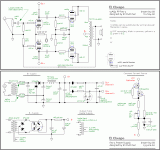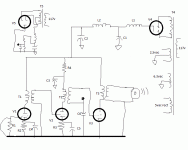I'm a long time DIY'er; first time posting... For many years (as a hobby), I've been trying various 'front ends' to drive a fixed bias 2a3se amp. I've found a circuit that is amazing using a 6sn7 ll1660 coupled to a 5687 NC20 coupled to 2a3se. The power supply is LCLC.. 5H, 50uf, 10H, 200uf, (the last of which is 2x 100uf black gate wkz 550v). The entire amp runs off of that black gate, with the exception of the 5687, which has a series R to drop it's operating point to 180vpk (14ma) with 150uf at the B+ of the NC20. After more than a year of use, the amp began oscillating (the lowthers actually 'breathing') at right around 2Hz. Could anyone explain to me what exactly causes this? After noticing this, I found it took over a half hour after power on to have oscillation develop. When troubleshooting.. I replaced -all- the caps with cheapo mallory electrolytics, and oddly enough, it would oscillate within seconds of warm-up. When I remove either the sn7 or 5687's cathode bypass cap, it stabilizes. When it's oscillating, I put a short across either of the coupling transformers secondaries, and it stabilizes. I remove the short, and in a second, it comes back, ramping up in amplitude throughout the amp. Can anyone help explain this?
Last edited:
Did you say you have a 6SN7 driving a 5687 driving a 2A3?
You have lots of gain from the 6SN7 to the 2A3.
Why are you powering the 6SN7 and 2A3 off the same Black Gate capacitors.
Try another resistor and Black Gate to run the 6SN7.
How about checking the 6SN7 and 5687, are they still running the same amount of current as when new? Did they age?
A weak tube will have higher plate resistance. suppose the interstage transformer that it drives is magnetically coupled to the output transformer. With a higher plate resistance driving it, it will be more susceptible to picking up the output transformer field.
How are the windings of the 3 transformers oriented. They should all be at right angles
to each other, or placed very far apart.
You have lots of gain from the 6SN7 to the 2A3.
Why are you powering the 6SN7 and 2A3 off the same Black Gate capacitors.
Try another resistor and Black Gate to run the 6SN7.
How about checking the 6SN7 and 5687, are they still running the same amount of current as when new? Did they age?
A weak tube will have higher plate resistance. suppose the interstage transformer that it drives is magnetically coupled to the output transformer. With a higher plate resistance driving it, it will be more susceptible to picking up the output transformer field.
How are the windings of the 3 transformers oriented. They should all be at right angles
to each other, or placed very far apart.
yes, it is motorboating.. I would like to know the exact cause. Yes it is alot of gain, I'd like to focus on an engineering explanation of the cause before I comment on the topology. No, it is not tube aging... I have dozens and dozens of tubes, and have tried them. No, it is not layout, the amp worked fine for several years before doing this. Yes, it is a decoupling issue... as is shown when I replaced all the caps in the entire amp with the same value (new unused) mallories, the behavior became more prominent (went from needing a half hour to begin to motorboat, to motorboating as soon as the tubes would be warm enough to conduct on power-up). I know oscillation is a gain/phase phenomenon.. and at 2Hz, the capacitive reactance of the 200uf is about 400ohms. The entire amp (three tube stages in parallel, as seen by the 200uf would be in the neighborhood of 700 ohms). This happens with the sn7 grid tied to ground.. so the entire circuit is unstable, and I am curious the cause... The B+ is about 256 volts, intended for the 2a3 with voltage drop of the OPT dcr accounted for. The sn7 is trying to get as close to 250v across it.. requiring it's load (ll1660) to be wired right to the 200uf. By the way, if i remove the cathode bypass capacitor of either the sn7 or 5687, the circuit stabilizes.
Last edited:
Put a scope on the power supply. AC couple it with a high voltage cap about .47UF should be OK. Watch it as the amp warms up. L-C supplies can resonate quite nicely. Yours resonate at about 10 hz for the first section and the second at about 3.5 hz. I know that LCLC is all the rage but I have always found LCRC work better or in my case Active Regulators can't motor boat. You are right at the 3rd harmonic in the supply the way it is. I would change the value of one of the power supply caps and change the harmonic relationship or remove the second L and put in a resistor.
Last edited:
I see where you get the 10hz and 3.5hz numbers. 'You are right at the 3rd harmonic in the supply' -could you clarify this? Are you able to expand on.. what is the relationship between the supply, and the amplifier circuit in my case. Why does removing a cathode bypass cap stabilize it? Is it because they are way larger in value in uf, than the supply.. thus the amplifier is wider in bandwidth (LF-wise) than the power supply is capable? (or am I off subject)
You probably have too much series resistance in your supply. Even when the amp is not oscillating it probably has a peak in response around 2Hz. Try taking the power output stage supply from the cap before the final choke instead of after it. It is a common newbie error to think that the main issue with a PSU is getting hum very low by adding smoothing sections.
Cathode bypass caps modify the LF and subsonic phase shifts so can create or reduce low frequency instability.
Cathode bypass caps modify the LF and subsonic phase shifts so can create or reduce low frequency instability.
The 2A3 is not a hard tube to drive, a single 5687 in the proper circuit will do the job if you do not need high sensitivity, also true in fact of the 6SN7..
If you need more gain a 6SL7 mu follower running at 2mA will do the job well.
Sounds like more decoupling between stages is in order, and more than likely given the age of those Blackgates their ESR has increased sufficiently over time and use to cause this problem.
If you need more gain a 6SL7 mu follower running at 2mA will do the job well.
Sounds like more decoupling between stages is in order, and more than likely given the age of those Blackgates their ESR has increased sufficiently over time and use to cause this problem.
This is what I think your problem is:
You are running your Input and Output stages off the same LCLC tap from your supply. Fine. But then you are then running your driver stage off an RC connection from the same LCLC tap (!)
If you simply post your schematic then you might get some better answers. You don't need to post all the "values" if you think it must be kept "top secret".
Best regards
Ian
You are running your Input and Output stages off the same LCLC tap from your supply. Fine. But then you are then running your driver stage off an RC connection from the same LCLC tap (!)
If you simply post your schematic then you might get some better answers. You don't need to post all the "values" if you think it must be kept "top secret".
Best regards
Ian
Now we're getting somewhere! I'd like to share this amp with everybody! It took me over a decade of trying different topologies in front of a 2a3se (PM2A Medallion II speakers) until I came across this one. It's performance is unlike anything I've tried before. And it worked great until recently, when I noticed the speakers 'breathing'. And I agree about the Black Gate age and ESR being a likely cause... but I got more curious when I replaced -all- the electrolytics (black gate) with new (xicon not mallory.. my bad) caps; and it would oscillate right away. Before I go any further, since I'm a long time reader, first time poster.. am I able to mention all the brand names for the parts I'm using. I don't know what the rules are.
Ok, I'll stick my neck out and suggest that you might have built a phase shift oscillator.
There are different kinds of oscillators that it might be. I tend to think in terms or RC oscillators, but it could be an LC oscillator. Without a schematic we simply can't be sure.
There was good advice posted already on how to possibly un-build your oscillator.
There are different kinds of oscillators that it might be. I tend to think in terms or RC oscillators, but it could be an LC oscillator. Without a schematic we simply can't be sure.
There was good advice posted already on how to possibly un-build your oscillator.
j8ke1,
I never saw a schematic of your amp.
Can you post it, please?
That is usually a good place to begin in troubleshooting.
The amp was 'stable' a year ago, but it may always have been very near the point of oscillating.
A small change could cause it to always oscillate.
Removing one cathode bypass cap not only changes phase response and frequency response, it also reduces gain.
Gain, Phase, and feedback (desired, or undesired/hidden) can equal instability.
Perhaps you have a couple of problems:
Power Supply Resonance
A year old ground connection that has corroded (bad contact).
I never saw a schematic of your amp.
Can you post it, please?
That is usually a good place to begin in troubleshooting.
The amp was 'stable' a year ago, but it may always have been very near the point of oscillating.
A small change could cause it to always oscillate.
Removing one cathode bypass cap not only changes phase response and frequency response, it also reduces gain.
Gain, Phase, and feedback (desired, or undesired/hidden) can equal instability.
Perhaps you have a couple of problems:
Power Supply Resonance
A year old ground connection that has corroded (bad contact).
Now we're getting somewhere! I'd like to share this amp with everybody! It took me over a decade of trying different topologies in front of a 2a3se (PM2A Medallion II speakers) until I came across this one. It's performance is unlike anything I've tried before. And it worked great until recently, when I noticed the speakers 'breathing'. And I agree about the Black Gate age and ESR being a likely cause... but I got more curious when I replaced -all- the electrolytics (black gate) with new (xicon not mallory.. my bad) caps; and it would oscillate right away. Before I go any further, since I'm a long time reader, first time poster.. am I able to mention all the brand names for the parts I'm using. I don't know what the rules are.
Changing the caps just retuned the circuit to different frequencies and it starts to osc. at start up now. Just different value caps that's all. Good, bad, old, new doesn't matter. just a different value. I would think that if you put a 300 ohm high watt resistor across L2 it would stop.
- Status
- This old topic is closed. If you want to reopen this topic, contact a moderator using the "Report Post" button.
- Home
- Amplifiers
- Tubes / Valves
- DIY 2a3SE oscillation question!

